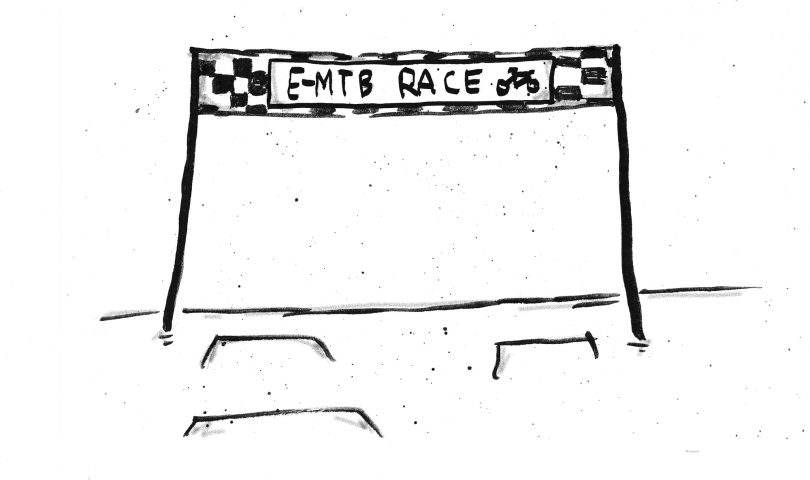Opinion: eMTB = MTB substitute?
The New York Times, Germany’s ZEIT magazine, the BBC, the Wall Street Journal – it seems like everyone’s talking about the Beyond Burger: the meat that’s not meat, the revolution on your plate. But while most global news channels are obsessing over the flavours and consistency of the plant-based, fake-meat burger, they skim over the tragic reality of this scenario.
Funnily enough, the fake meat debate covers much of the same rhetoric as eMTBing. It’s all about the ingredients: pea protein base, cellulose from bamboo, potato starch, gum arabic, ascorbic acid, rapeseed oil, beetroot juice for colour and as a blood substitute – hadn’t you heard that veggie burgers also have to bleed when they’re on the barbeque? However, no one talks about the sense behind this, or lack thereof. There are so many great tasting vegetables so why can’t we appreciate all the flavours they can offer?

Does an eMTB really have to ride like a mountain bike? What defines the idea that it must ride like a mountain bike? According to brands and magazines, the bike should be as light as possible, go as far as possible, with as much agility and efficiency as possible. But what if I’m looking for a safer bike for a variety of applications from trail riding and family excursions to daily offroad-commuting? What if the potential of ebikes has been so broadened by having a motor that a whole new genre has emerged? What if it is no longer the bike that defines the purpose, but the individual? Why do we struggle to accept that an eMTB will never be a mountain bike? Is it not crazy to stick to the same old standards for a brand new product?
It’s a phenomenon we recognise from business. Every billion-dollar company has sought out so-called maverick thinkers and visionaries over the past few years, wanting them to ‘think differently’ and ‘break the rules’ because they’re ‘ready for the future.’ Bullshit – no one is ready. After all, the underlying message is usually: ‘Be creative, but don’t upset the established order.’ When it comes to it, lateral problem solving quickly becomes conventional. Change, yes please, but don’t upset the hierarchy or the system. Welcome to the world of part-time lateral thinkers.

The idea of eMTB development often follows the same pattern. Almost everyone is guided by the conventions and values of conventional mountain bikes and therefore creates advertising campaigns (and ultimately bikes) that respond to the questions of yesteryear instead of addressing the needs of the new eMTB generation. The most current example is the discussion about eMTB racing, that some players in the industry feel an urge to establish, although no one has found a reasonable format yet. The inevitable excitement about how the sport should be run has led many to forget that racing will bring its own unique problems that could damage the growth of the industry. Of course, there is interest from professional riders facing the financial void of retirement, but the vast majority of eMTBers, as demonstrated by our recent reader survey with more than 10,000 participants, are simply not inclined to compete. Just because mountain biking has a variety of racing disciplines, it does not mean that eMTB riders need a racing discipline too.

This notion hits the nail on the head of bike development as well. Take a look at the history of eMTBs and you’ll find that from the earliest iteration of clunky mountain bikes with a motor bolted on, to the emergence of more refined eMTB designs, so far they have all tried to emulate a traditional mountain bike. That might be changing though. The market is starting to differentiate. On the one hand, you’ve got lightweight mountain bike-esque concepts like the Lapierre eZesty, and on the other, you’ve got radical motorised bikes like the Haibike FLYON series with the powerful TQ motor, which are being dubbed ‘the first true eMTBs’ by some in the industry. Is it a no-go if a bike weighs close to 30 kg? Who knows, but the market will tell you the answer soon enough. The fact is, while mountain bikers continue to throw shade and judgement, eMTBers aren’t afraid to try new technologies. We’ve seen in the last year already that SUV style eMTBs are becoming a huge trend. [Spoiler alert: we’ve tried that 30 kg bike and can tell you we’re damn excited! Read the full review in our Group Test where we define ‘The Best eMTB of 2019’.]
It’s a crying shame when eMTBs are only used for the same old thing you did with your mountain bike before. It’s like only using your iPhone for calls because that’s what you did with your Nokia 3310. Oh, and perhaps the odd SMS.

The problem is clear: Change, or the lack of it. No one is willing to change. That comfort zone is just too comfortable. But those who want to help shape the future (or at least understand it) have to be able to let go – not just of the past, but also of the outdated and misconceived convictions born out of the past. The potential of eMTBs can only be realised and appreciated with an open mind. The root of all the issues we’ve mentioned: Fear. You have to leave the safety net with a willingness to throw yourself into the chaos of the unknown and a market that still doesn’t know its head from its tail. In the same way that we talk of tofu sausages, seitan steaks and veggie schnitzels, it’s evident that we are unwilling to miss out on something, unwilling to step outside the confines of standard meat-feast barbequeing. Those fake meat products get meaty names to soothe our spirits with a substitute, but keep us chained to what we already know.

Yet the solution is glaringly obvious. We don’t need a crystal ball to tell us. We have everything we need: thousands of eMTBers that already use their bikes in many new ways. You, our wonderful readers, each one of you has your own story and dreams. If the industry could stop chasing a phantom ideal that’s been born out of an overload of mountain bike riding in its blood and instead turned its attention to what you guys truly want, then we could shape the greatest future. A joint future that addresses the real problems and issues, without technical gimmicks, but true solutions. Over the past years, we’ve realized that hardly anyone in our industry does extensive market studies or analysis. Bike development is largely driven by the engineers – they ask themselves ‘can we do it?‘, but hardly anyone questions ‘should we do it?‘ Marketing departments need a new role, where they aren’t just relegated to marketing the products that the engineers have created, but are helping to identify what the market needs now and in the future, and driving forward strategies that address those needs. We can’t mistake technology for solutions.

So how did the Beyond Burger taste? Well, a hell of a lot like a real meat patty, but more like one of those burgers that have sat on the delivery shelf for too long than a primo cut of quality meat. Being able to imitate something well doesn’t make something great. I don’t want to cause offence to the fake meat burger – on the contrary, if it can make people happy then that’s brilliant. But please stop seeing something new as a substitute for something old. This stops us from truly scoping out the full potential of eMTBs. Forget the substitutes. Let’s make an original. eMTBing isn’t just a sport – it’s an attitude.
This article is from E-MOUNTAINBIKE issue #016
E-MOUNTAINBIKE Magazine is published in a digital app format in both English and German. Download the app for iOS or Android to read all articles on your tablet or smartphone. 100% free!

Words: Robin Schmitt Illustration: Julian Lemme
Did you enjoy this article? If so, we would be stoked if you decide to support us with a monthly contribution. By becoming a supporter of E-MOUNTAINBIKE, you will help secure a sustainable future for high-quality cycling journalism. Click here to learn more.










